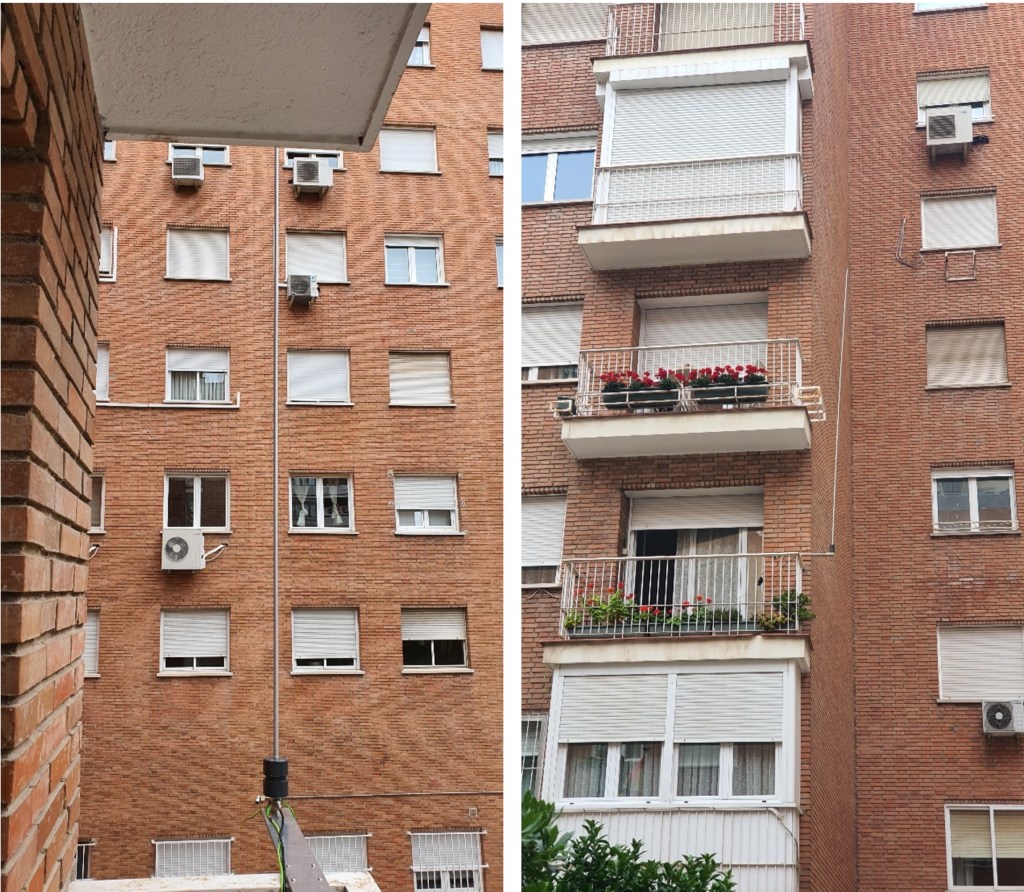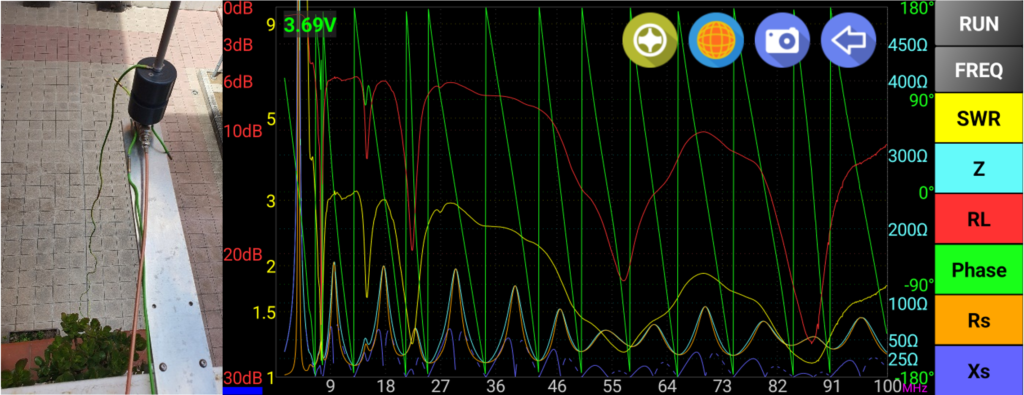2024-06-18+19. Initial tests.
After VNA testing (https://ea4hcn.es/2024/07/08/measuring-initial-vna-tests-of-alpha-automatch-and-autot-6-25/), it was decided to retain the 3.88 and 5m radiators for “on the air tests”. The first test was to connect the antenna to an FTDX10 or to an FT-710 and see what happened in all bands when activating “tune” procedure.

3.88 m antenna under testing.
With the 5 m radiator, from VNA readings, it wasn’t expected a tuning solution below 7 MHz. But in 3.5 MHz band, as with the original Alpha, it was found. As in all other bands.
Then, a few FT-8 contacts were made in 14, 18 and 21 MHz. PSK reporter showed reception reports from all Europe and the East coast of the USA.

PSK reporter monitoring graph. 2024-06-17, 5 m radiator.
On the next day, it was tested the 3.88 m radiator. Again, the autotuner did its job without issue from 3.5 MHz to 6 m. A few FT8 contacts were made in 10 and 14 MHz, although propagation conditions were not too good. PSK reporter did show reception reports only in Europe.

PSK reporter monitoring graph. 2024-06-18, BN43 core, 3.88 m radiator.
Update 2024-06-19. BN-43 overheating
While testing the antenna in FT8, at 100 W output, it was noticed that SWR started to rise slowly. This was a bad symptom. After an FT 8 session, with some contacts, the AutoT felt warm, so it was open for inspection. The binocular core was very, very hot. Worse symptom. That meant that the core (and the device) is a lossy one. Too lossy. Indeed, this can explain the low FM/digital modes rating of Alpha and Chameleon “Matching Devices”.
SWR rise can be explained by the low Curie Temperature (Tc) of material 43. In its datasheet, it is specified that Tc > 130 ºC. Above this temperature, the magnetic properties would change, including a substantial decrease in permeability. Core temperature wasn’t measured, but it is likely that it was above 150 ºC (more on this in the post on summer QTH tests).
2024-06-20 update. Change to BN-61 core
In view of the issues with BN-43-7051 core, it was decided to replace it by a BN-61-002, and retest SWR and operation.
SWR readings weren’t too good. When using the 3.88 m aluminium rod, SWR and lower cutoff frequency were higher than when using BN-43 core.

PSK reporter monitoring graph. 2024-06-19, BN61 core, 3.88 m radiator.
FT-710 autotuner was capable to find a match only for and above 10 MHz. Not on 7 MHz and below. On the other hand, reception reports by pskreporter improved. In the absence of field strength measurements, this was a positive indicator.
2024-06-21 update: Adding parasitic inductance
It wasn’t clear why performance below 10 MHz was not too good. Analysis of inductance readings suggested that possibly it could be due to too low inductances, including parasitic inductance. To test this hypothesis, a small BN-43-202 core was slipped in the output wire of AutoT 6.25. Output parasitic inductance raised from 0.55 to 2.0 μH.
SWR readings improved slightly (from 5.6 to 4.4). However, SWR improvement was not sufficient to allow rig’s autotuner to find a match.

SWR before (base) and after (Ind_Par) adding parasitic inductance.

SWR before (base) and after (Ind_Par) adding parasitic inductance. Detail 0-20 MHz.
On the other hand, operation at 10 MHz and above was satisfactory. Operation tests were continued in the morning (around 07:30 UTC, 09:30 CEST). PSK reporter reception monitoring had good aspect. Especially encouraging was that it was possible to make a FT8 QSO with Costa Rica in 14 MHz.

WSJT-X screenshot. 2024-06-21, BN61 core, 3.88 m radiator.

PSK reporter screenshot. 2024-06-21, BN61 core, 3.88 m radiator.
2024-06-23. Extending down operating range
To check if it was possible to shift down the cutoff frequency, some additional tests were carried out. First, using a longer counterpoise (4.8 + 2 m = 6.8 m). A short wire stub (0.45 m) was attached to the base of the radiator, in anticipation to the next test.

BN61 core, 3.88 m radiator + 0.45 m stub, 6.8 m counterpoise.

VNA graph. BN61 core, 3.88 m radiator + 0.45 m stub, 6.8 m counterpoise.
The longer counterpoise didn’t change significantly the cutoff frequency. SWR @ 7 MHz was still outside the matching range of FTDX10 autotuner.
Therefore, we proceeded to the next test. The counterpoise was reverted to its original length. The 2 m wire section was attached to the 0.45 m stub, making a hanging 2.45 m wire from the base of the Aluminium rod.

BN61 core, 3.88 m radiator + 2.45 m hanging wire, 4.8 m counterpoise.

BN61 core, hanging wire vs longer counterpoise. Detailed comparison 0-20 MHz.
This alteration improved significantly SWR in 7 MHz band (2 vs 4), to the point of allowing the autotuner to do its job. SWR was higher from 9.5 to 14.5 MHz; but was still in autotuner’s matching range. Some FT8 QSOs were made, but not too many. At 16:45 local time (14:45 UTC), propagation wasn’t excellent. Or there were not many stations on the air. Most reception records came from Europe, and USA East coast. Nevertheless, the station was heard in Japan on 21 MHz!
On the other hand, although BN-61 core losses were lower than BN-43’s, heating of UNUN’s core was still perceptible. However, never to the point of having effect on its magnetic properties. Or at least, not to the point of having a noticeable effect on SWR.

Tests with 2.45 m hanging wire. PSK reporter screenshot.

About the author